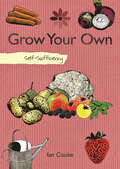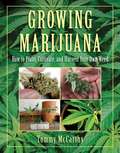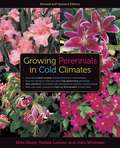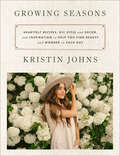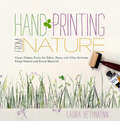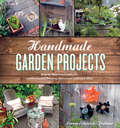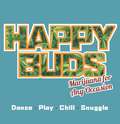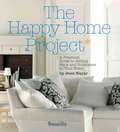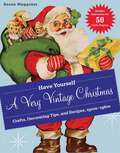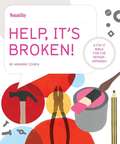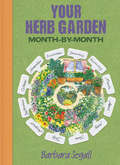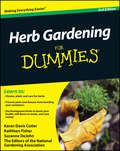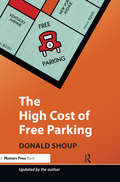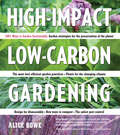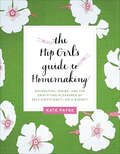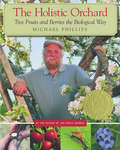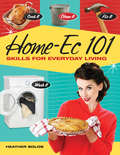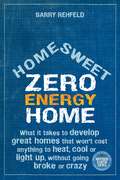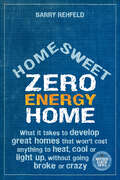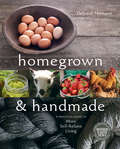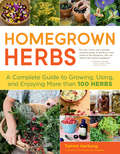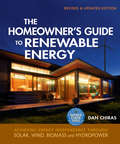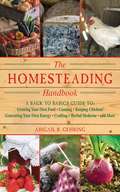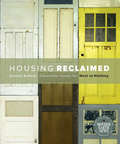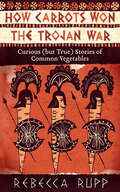- Table View
- List View
Grow Your Own (Self-Sufficiency)
by Ian CookeReap the advantages of backyard-to-table produce with tips on planning, soil, fertilizers, cultivation, pests, and diseases. Includes a Quickstart Guide! This is a simple and systematic guide to growing a selection of the tastiest fruit and vegetables. The aim of this book is to start you off with some easy-to-grow produce such as carrots, onions, radishes, tomatoes and strawberries. Once you have the confidence of the first growing season behind you, you can then progress to crops requiring slightly more labor, such as peas, beans and raspberries. When you grow your own produce, you can be absolutely sure that everything has been organically cared for and you can grow just the variety you like. You can pick the fruit and vegetables at their freshest without a tiresome journey to the supermarket. It&’s satisfying, it&’s economical and it&’s delicious.
Growing Marijuana: How to Plant, Cultivate, and Harvest Your Own Weed
by Tommy MccarthyMarijuana seeds are legal to buy and-with some soil, water, and light-can grow into one of humanity's favorite pastimes. Call it pot, bud, cannabis, ganja, dope-if you have the seeds, you can grow the weeds. Here are step-by-step directions to growing and managing your own marijuana plants. The author discusses both in-door and outdoor growing, including information on: Choosing the right plants for your needs Where to buy seeds How to germinate the seeds How to nurture the plants How to prepare the final product Problems to avoid And more! In addition to more than 100 full-color, step-by-step photographs, the book features an extensive list of resources, making it the essential guide you need to grow your own weed.
Growing Perennials in Cold Climates
by Mike Heger Debbie Lonnee John WhitmanGrowing Perennials in Cold Climates is an excellent resource for selecting, siting, planting, and maintaining perennials that flourish in northern climates. This expanded edition identifies the fifty most popular perennial groups, offers in-depth information on wild and cultivated varieties best suited to cold climates, and rates more than 500 of the choicest plants. In addition to the plant data, this book includes a concise course in perennial gardening, from preparing a site and buying potted perennials to composting, watering, mulching, fertilizing, weeding, staking, deadheading, pruning, protecting plants in winter, companion planting, and dealing with disease and insect problems. Owning this guide is like having a professional gardener at your side every step of the way. Written to make even the most sophisticated aspects of growing perennials easy to understand, this book will be indispensable to novice and advanced gardeners alike.
Growing Seasons: Heartfelt Recipes, DIY Style and Décor, and Inspiration to Help You Find Beauty and Wonder in Each Day
by Kristin JohnsPull up a chair and gather in close with entrepreneur and content creator Kristin Johns as she shares her best-kept secrets: mouthwatering recipes, design inspiration, and ways we all can grow, celebrate, and find nourishment in every season of life. Kristin Johns long dreamed of putting together a book of favorite recipes, ideas for interiors, and reflections on faith, family, and love. Growing Seasons is a gorgeously photographed collection of stories, recipes, and inspiration that encourages us to step into each day with courage and authenticity, and to embrace every season of life.Just as each month has its own specific character, each season of life has its own unique challenges and opportunities, all with valuable life lessons to teach us. Walking through the calendar year from January to December, the book’s twelve chapters feature:Kristin’s favorite recipes like Christmas Morning Sourdough Cinnamon Rolls, CeCe’s Famous Cajun Gumbo, a Sunny Citrus Kale Salad and, of course, Kristin’s famous Chocolate Chunk Cookie recipeCreative projects such as Rustic Hand Dyed Linens, DIY Lavender Blue Tansy Skin Serum, and five easy tricks to minimize clutter and maximize coziness at homeFun ideas to entertain and connect with others through Summer Getaway Essentials and a guide to movie night at home complete with homemade pizza and caramel cornWhether you’re looking for adventure or a chill night at home, Growing Seasons will meet you where you are and inspire where you are going.
Hand Printing from Nature: Create Unique Prints for Fabric, Paper, and Other Surfaces Using Natural and Found Materials
by Laura Donnelly BethmannDiscover how to use natural materials to print on any surface, from paper and fabric to ceramics, wood, and walls. With simple step-by-step instructions and clear photographs, Laura Bethmann encourages crafters of all levels to create original nature prints with leaves, flowers, fruits, shells, stones, and more. Her unique project ideas include stationery printed with maple leaves, a clothes hamper printed with scallop shells, and a pillow printed with cabbage. Before you know it, you’ll be designing one-of-a-kind nature prints to reflect your unique personality and style.
Handmade Garden Projects: Step-by-Step Instructions for Creative Garden Features, Containers, Lighting and More
by Lorene Edwards ForknerYour journey to a made-from-scratch outdoor space starts here. Transform your yard into a beautifully personalized retreat with 30 step-by-step projects! The finished pieces include creative pathways, unique support structures, DIY water features, clever containers, and special finishing touches that help bring your garden to life. With easy to follow instructions, lush color photography, and sidebars filled with helpful tips and additional ideas, Handmade Garden Projects is an inspiring step toward a more stylish space.
Happy Buds
by Ed RosenthalWhat's the best bud when you go out to party and want to live it up? Feeling a little down and need to let go? Feeling stressed and need to slow down? Need to focus on a complicated task?Even the casual user knows the two types of marijuana, indica and sativa, and within these broad categories are literally thousands of varieties, each with its own effects. Marijuana botanists have crossbred varieties to enhance or diminish characteristics. Happy Buds is all about the effects of these varieties and the choosing which buds to select will open new doors for casual and regular users alike.Thirty million Americans openly admit to using marijuana regularly, the market for Happy Buds is already huge and growing every day. Some use it to help get their day started, some to help them focus deeply on the task at hand and some to just help them chill and end their day with a good night's sleep.Derived from the successful Big Book of Buds series, Happy Buds gives the reader guidance with up to five choices of buds that work best for over 20 occasions. As the number of states (15 as of November 2010) that have legalized medical marijuana and the number of dispensaries grows, finding that perfect bud, seed or plant has become much easier.Ed Rosenthal is the most recognized author of marijuana books with aggregate sales over two million copies, most recently The Big Book of Buds 4 and Marijuana Grower's Handbook.
The Happy Home Project
by Jean NayarWe all want beautiful homes that reflect our personal style. But the happiest homes don't just look good-they also feel good. Ideally, they support the way we live, keep us healthy and safe and enrich our net worth, too. So how do we create homes that truly make us happy? In The Happy Home Project, author Jean N ayar looks not only at the material things that contribute to the beauty and style of a house, but also explores the hidden elements and intangibles that add to its substance and soul. Brimming with beautiful photos and filled with expert advice from architects, designers, organizing experts, and contractors, the book offers easy-to-follow guidance on how to create inspiring, stylish rooms as well as practical tips on how to invest wisely in furniture and improvements that will add value to your home-and your quality of life. Focusing on comfort and harmony with nature, the book taps into the wisdom of poets, philosophers and social scientists-as well as experts of the ancient Asian building philosophies of feng shui, vastu shastra, and wabi-sabi-to reveal some of the subtler steps that anyone can take to turn to an ordinary, impersonal house into an uplifting, personal sanctuary.With helpful hints on everything from corralling clutter, picking paint and arranging furniture to refinishing floors, replacing windows and remodeling a kitchen, The Happy Home Project is a great go-to guide for home improvement projects, large and small. Whether your home needs a major makeover or just a little fine-tuning, the ideas, solutions and tips in this book will help you increase its happiness quotient-and let you live well in any dwelling and at any stage of life.
Have Yourself a Very Vintage Christmas: Crafts, Decorating Tips, and Recipes, 1920s–1960s
by Susan WaggonerRecapture the magic of Christmases past with fifty easy-to-make craft projects, candy recipes, and nostalgic retro art!Inspired by the most sought-after treasures from the 1920s through the 1960s, Susan Waggoner recreates a tempting array of decorations and provides step-by-step instructions that allow anyone to deck their halls with cellophane wreaths, glittered glass ornament balls, beaded bell garlands, and whimsical, tinsel-bedecked treat cups. Those pressed for time will also find quick crafts for every decade, along with style notes and decorating tips to pull it all together. Nostalgic art provides a host of images to use in greeting cards and photo holders. And to keep spirits merry and energy flowing, Waggoner includes a sampler of easy-to-make candy recipes, from Mackinac Island Fudge to old-fashioned soft caramels.
Help, It's Broken! A Fix-it Bible for the Repair Impaired
by Arianne CohenNo matter where you live and whether you rent or own, one day you'll wake up in the morning and something will be broken. This book will come in handy to avoid panic and home repair disasters because a good reference guide is just what you need when there's a geyser in your living room. Count on this manual to tell you what to do or who to call to get the mess fixed.This useful book includes chapters on: Walls, Doors, Windows and Floors; Electricity; Appliances; Plumbing; Heat and Ventilation; Pests; Frugal Fixing and more. Each section is illustrated and explains the basics of how things operate before detailing how to fix them in a few easy steps. It also teaches you not only how to fix things yourself but also how to get someone who knows what they're doing to fix things for you and what questions to ask. This quick and informative guide can save you thousands of dollars and a lot of hassle. From unclogging drains to expelling rodents, from repairing stained carpet to fixing your dishwasher, you can depend on this book in any number of household catastrophes. Even if you can barely tell a nut from a bolt, Help! It's Broken is your quick reference guide for all home-repair solutions. Consider it a toolbox essential.
Herb Garden month by month: Month-by-month (Month-by-Month)
by Barbara SegallThe Herb Garden covers everything the gardener needs to know in order to cultivate, harvest and use a vast array of different herbs. There is a wealth of practical information on growing and planting is provided in a clear, easy-to-use, month-by-month format, allowing gardeners instantly to find the advice they need, when they need it. This title provides an introduction to the herb garden for each month, along with straightforward instructions and a checklist for seasonal tasks. It offers easy-to-follow projects, from designing a herb garden to harvesting herbs for scented gifts, are achievable by all.
Herb Gardening For Dummies
by National Gardening Association Suzanne Dejohn Karan Davis Cutler Kathleen FisherA plain-English guide to the world of herb gardeningStarting an herb garden isn't free, but it certainly outweighs the growing costs of buying retail herbs. Plus, adding homegrown ingredients to your meals is a healthy and tasty way to improve upon any dish you whip up at home.This friendly, hands-on guide is an excellent introduction to the world of herb gardening. It gives you tips and advice to grow a thriving herb garden that will add depth and flavor to home-cooked meals-as well as boost your health.How to choose, plant, and care for herbsCovers ready-made versus homemade soil mixes, starting plants from seeds, and other fundamentalsHow to prevent insects, pests, and diseases from invading your containersOver 30 herb recipes for everyday uses, including rubs, marinades, beauty products, and moreWhether you're interested in getting step-by-step instructions for starting on your first herb garden or already have one and want to learn new tips and techniques, Herb Gardening For Dummies, 2nd Edition has you covered!
The High Cost of Free Parking: Updated Edition
by Donald ShoupOne of the American Planning Association’s most popular and influential books is finally in paperback, with a new preface from the author on how thinking about parking has changed since this book was first published. In this no-holds-barred treatise, Donald Shoup argues that free parking has contributed to auto dependence, rapid urban sprawl, extravagant energy use, and a host of other problems. Planners mandate free parking to alleviate congestion but end up distorting transportation choices, debasing urban design, damaging the economy, and degrading the environment. Ubiquitous free parking helps explain why our cities sprawl on a scale fit more for cars than for people, and why American motor vehicles now consume one-eighth of the world's total oil production. But it doesn't have to be this way. Shoup proposes new ways for cities to regulate parking – namely, charge fair market prices for curb parking, use the resulting revenue to pay for services in the neighborhoods that generate it, and remove zoning requirements for off-street parking. Such measures, according to the Yale-trained economist and UCLA planning professor, will make parking easier and driving less necessary. Join the swelling ranks of Shoupistas by picking up this book today. You'll never look at a parking spot the same way again.
High-Impact, Low-Carbon Gardening: 1001 Ways to Garden Sustainably
by Alice BoweThe environmental benefits of gardens are well-known: trees and plants capture carbon emissions, help to moderate the urban climate, promote health and well being, and help reduce energy consumption. But some garden practices are downright damaging, like using leaf blowers and other power tools, installing impermeable paving, and choosing plants that require excessive water or artificial fertilizers. High-Impact, Low-Carbon Gardening is a one-stop reference for making a garden more green. From simple actions like composting household waste, installing a water barrel, or eliminating pesticides to more long-term investments like choosing permeable, locally sourced paving, and planting the most water-wise plants, there are hundreds of large and small choices home gardeners can make to reduce the environmental impact of designing, planting, and tending a garden. High-Impact, Low-Carbon Gardening goes beyond organics and compost and gives serious gardeners all the information they need to make their garden truly green.
The Hip Girl's Guide to Homemaking: Decorating, Dining and the Gratifying Pleasures of Self-Sufficiency--on a Budget!
by Kate PayneWith The Hip Girl's Guide to Homemaking, it's possible and even convenient to create an inviting space for living and entertaining on a budget. From unique decor ideas to growing strawberries on your fire escape, Kate Payne shares fun, low-cost (and often free!) creative solutions that will make anyone feel more accomplished in minutes.Inside this savvy motivational guide filled to the brim with small-scale creative home projects, Kate's tongue-in-cheek tone will keep you tuned in to her much-needed advice. In three easy sections, you'll learn how to create a comfortable space while being time- and budget-conscious. Section One, Home-ify Your Pad, features quick, convenient ways to make your place cozier with low-cost, special touches to help you tap into and show off your inner artist. Section Two, Impressive Acts of Domesticity, teaches how to impress others (and yourself) with the gratifying pleasures of self-sufficiency—a first-time guide to cleaning, sewing, repairing, and other previously out-of-the-question tasks. Section Three, Life After Restaurants, frees you to release the take-out menu, avoid pricey bar tabs, and entertain others in the space you've so thoughtfully and gorgeously created. User-friendly "how-to" sidebars, illustrations, and tips and tricks throughout the book offer easy-to-follow recipes and do-it-yourself craft suggestions for making your home hip, comfortable, and inviting. Keep in mind that this is not your grandmother's handbook and it's not the kind of wisdom your mom knows how to impart. Modern women need a modern approach to domestic pleasures—a guide to doing household things on our own terms, because most of this stuff isn't as hard as we've been led to believe. Don't worry, she's not asking you to host Tupperware parties or iron your underwear. But as all beginning home keepers know, a sure fire way to feel bad about ourselves is to consult Martha Stewart. So ditch that 2-inch thick handbook, dust off your pots and pans, and join Kate on this journey to incorporating creativity and self-sufficiency on the home front.
The Holistic Orchard
by Michael PhillipsMany people want to grow fruit on a small scale but lack the insight to be successful orchardists. Growing tree fruits and berries is something virtually anyone with space and passionate desire can do - given wise guidance and a personal commitment to observe the teachings of the trees. A holistic grower knows that producing fruit is not about manipulating nature but more importantly, fostering nature. Orcharding then becomes a fascinating adventure sure to provide your family with all sorts of mouth-watering fruit. The Holistic Orcharddemystifies the basic skills everybody should know about the inner-workings of the orchard ecosystem, as well as orchard design, soil biology, and organic health management. Detailed insights on grafting, planting, pruning, and choosing the right varieties for your climate are also included, along with a step-by-step instructional calendar to guide growers through the entire orchard year. The extensive profiles of pome fruits (apples, pears, asian pears, quinces), stone fruits (cherries, peaches, nectarines, apricots, plums), and berries (raspberries, blackberries, blueberries, gooseberries, currants, and elderberries) will quickly have you savoring the prospects. Phillips completely changed the conversation about healthy orcharding with his first bestselling book,The Apple Grower, and now he takes that dialogue even further, drawing connections between home orcharding and permaculture; the importance of native pollinators; the world of understory plantings with shade-tolerant berry bushes and other insectary plants; detailed information on cover crops and biodiversity; and the newest research on safe, homegrown solutions to pest and disease challenges. All along the way, Phillips' expertise and enthusiasm for healthy growing shines through, as does his ability to put the usual horticultural facts into an integrated ecology perspective. This book will inspire beginners as well as provide deeper answers for experienced fruit growers looking for scientific organic approaches. Exciting times lie ahead for those who now have every reason in the world to confidently plant that very first fruit tree!
Home-Ec 101: Skills for Everyday Living
by Heather Solos Jacqueline MusserReal Skills for Real Life From keeping your home clean and in good repair to preparing your own food, self-sufficiency rocks. Having an understanding of the domestic arts gives you a sense of control over your life. These skills also help you save money, not by chasing deals, but by teaching the principle of the mantra: Use it up, wear it out, make it do, or do without. Life skills are the essence of frugality. Whether you just moved out of your parent's basement or you cut the apron strings a while ago, you'll learn the skills you need to manage your household. Inside you'll find: Quick, easy cleaning solutions for every room of the house, so you can get the job done and get on with life Instructions for removing stubborn stains and offensive odors from fabric Simple fixes to wardrobe malfunctions including broken zippers, missing buttons, and fallen hemlines Troubleshooting advice for common problems with home appliances A minimum home maintenance guide to prevent or catch major repair problems A basic plumbing tutorial that includes clearing and preventing clogs, stopping a running toilet and retrieving items dropped down a drain Ideas for healthy and fast meal planning so you can start cooking and stop relying on takeout or preservative-packed convenience food Definitions of common cooking terms and techniques found in recipes Plans for stocking a pantry so you can make dinner (even if you haven't been grocery shopping in a week) and be prepared when disaster strikes A complete rundown of essential kitchen equipment from knives to pans to small appliances Equip yourself with the skills you need for everyday life.
Home Sweet Zero Energy Home: What It Takes to Develop Great Homes That Won't Cost Anything to Heat, Cool or Light Up, without Going Broke or Crazy
by Barry RehfeldZero energy buildings produce at least as much energy as they consume through a combination of efficiency design and renewable technologies. Home sweet zero energy home shows how developing a better more environmentally friendly home doesn't have to break your back or your bank account.
Home Sweet Zero Energy Home (Mother Earth News Books for Wiser Living)
by Barry RehfeldZero energy homes produce at least as much energy as they consume through a combination of energy efficiencies, passive design, and renewable energy production. California has adopted zero net energy as the new residential standard for 2020; many other governments are considering similar policies. Developing zero energy homes is the first step towards making all buildings zero energy-a critical step in mitigating climate change, since buildings account for forty percent of material and energy use worldwide.Home Sweet Zero Energy Home is the first practical guidebook that clearly shows how zero energy homes can be good, livable, affordable homes. The author identifies all the pieces of the zero energy puzzle and how they fall into place, and explains how homeowners and buyers can also take smaller steps towards sharply reducing the energy use of existing buildings. Focusing on real costs and savings, this book takes an in-depth look at:*Site selection and passive design*Insulation, windows, doors, and building materials*Heating and cooling*Appliances and electronics*Financial resources and incentivesWhether you are a prospective buyer, owner, or developer, Home Sweet Zero Energy Home is your complete guide to creating a more comfortable, efficient, environmentally friendly home without breaking your back or your bank account.Barry Rehfeld has been a journalist for over thirty years and is the founder of the website Zero Energy Intelligence, where he writes about everything you need to know to build, buy, or renovate a home that produces as much energy as it uses.
Homegrown and Handmade
by Deborah NiemannOur food system is dominated by industrial agriculture and has become economically and environmentally unsustainable. The incidence of diet-related diseases, including obesity, diabetes, hypertension, cancer, and heart disease, has skyrocketed to unprecedented levels. Whether you have forty acres and a mule or a condo with a balcony, you can do more than you think to safeguard your health, your money, and the planet.Homegrown and Handmade shows how making things from scratch and growing at least some of your own food can help you eliminate artificial ingredients from your diet, reduce your carbon footprint, and create a more authentic life. Whether your goal is increasing your self-reliance or becoming a full-fledged homesteader, it's packed with answers and solutions to help you:*Take control of your food supply from seed to plate*Raise small and medium livestock for fun, food, and fiber*Rediscover traditional skills to meet more of your family's needs than you ever thought possibleThis comprehensive guide to food and fiber from scratch proves that attitude and knowledge is more important than acreage. Written from the perspective of a successful self-taught modern homesteader, this well illustrated, practical, and accessible manual will appeal to anyone who dreams of a simpler life.Deborah Niemann is a homesteader, writer, and self-sufficiency expert who presents extensively on topics including soapmaking, bread baking, cheesemaking, composting, and homeschooling. She and her family raise sheep, pigs, cattle, goats, chickens, and turkeys for meat, eggs, and dairy products, while an organic garden and orchard provides fruit and vegetables.
Homegrown Herbs: A Complete Guide to Growing, Using, and Enjoying More than 100 Herbs
by Tammi HartungEnjoy a thriving, fragrant herb garden and use your harvest to bring beauty, flavor, and health to your everyday life. Tammi Hartung provides in-depth profiles of 101 popular herbs, including information on seed selection, planting, maintenance, harvesting, and drying. Hartung also shows you how to use your herbs in a variety of foods, home remedies, body care products, and crafts. Whether you&’re a seasoned herbalist or planting your first garden, Homegrown Herbs will inspire you to get the most out of your herbs.
The Homeowner's Guide to Renewable Energy: Achieving Energy Independence through Solar, Wind, Biomass and Hydropower (Mother Earth News Books for Wiser Living)
by Dan ChirasThe Homeowner's Guide to Renewable Energy shows home and business owners how to make dramatic improvements in energy efficiency and tap into clean, affordable sources of renewable energy for heating, cooling, and generating electricity. This fully revised and updated edition includes expanded coverage of all areas, the latest advances in technology, and the economics of renewable energy systems.
The Homesteading Handbook: A Back to Basics Guide to Growing Your Own Food, Canning, Keeping Chickens, Generating Your Own Energy, Crafting, Herbal Medicine, and More (Handbook Series)
by Abigail R. GehringWith the rapid depletion of our planet's natural resources, we would all like to live a more self-sufficient lifestyle. But in the midst of an economic crisis, it's just as important to save money as it is to go green. As Gehring shows in this thorough but concise guide, being kind to Mother Earth can also mean being kind to your bank account! It doesn't matter where your homestead is located--farm, suburb, or even city. Wherever you live, The Homesteading Handbook can help you: Plan, plant, and harvest your own organic home garden. Enjoy fruits and vegetables year-round by canning, drying, and freezing. Build alternate energy devices by hand, such as solar panels or geothermal heat pumps. Differentiate between an edible puffball mushroom and a poisonous amanita. Prepare butternut squash soup using ingredients from your own garden. Conserve water by making a rain barrel or installing an irrigation system. Have fun and save cash by handcrafting items such as soap, potpourri, and paper. Experience the satisfaction that comes with self-sufficiency, as well as the assurance that you have done your part to help keep our planet green. The Homesteading Handbook is your roadmap to living in harmony with the land.
Housing Reclaimed
by Jessica KellnerHousing is a fundamental human right. For most of human history, our homes were built by hand from whatever local materials were available. However, since the Industrial Revolution, most housing has become little more than quickly constructed, mass-produced, uniform boxes. At the same time, the invention and standardization of the thirty-year mortgage and our ever-increasing reliance on credit has come to mean that most of us never own our homes outright.Housing Reclaimed is a call to arms for nonconventional home builders. It examines how technological advances, design evolution, and resourceful, out-of-the-box thinking about materials and efficiency can help us meet the challenge of building affordable, environmentally friendly, beautiful, and unique homes. Focusing on the use of salvaged and reclaimed materials, this inspirational volume is packed with case studies of innovative projects including:*Phoenix Commotion-working together towards low-income home ownership through sweat equity and 100 percent recycled materials*HabeRae-revitalizing neighborhoods by creating urban infill using modern technology and sustainable and reclaimed materials*Builders of Hope-rescuing and rehabilitating whole houses slated for demolitionThese projects and others like them demonstrate that building one's own home does not have to be an unattainable dream. This beautifully illustrated guide is a must-read for anyone interested in creating quality zero- or low-debt housing, reducing landfill waste, and creating stronger communities.Jessica Kellner is the editor of Natural Home and Garden magazine and a passionate advocate of using architectural salvage to create aesthetically beautiful, low-cost housing.
How Carrots Won the Trojan War: Curious (but True) Stories of Common Vegetables
by Rebecca RuppDiscover why Roman gladiators were massaged with onion juice before battle, how celery contributed to Casanova’s conquests, how peas almost poisoned General Washington, and why some seventeenth-century turnips were considered degenerate. Rebecca Rupp tells the strange and fascinating history of 23 of the world’s most popular vegetables. Gardeners, foodies, history buffs, and anyone who wants to know the secret stories concealed in a salad are sure to enjoy this delightful and informative collection.
